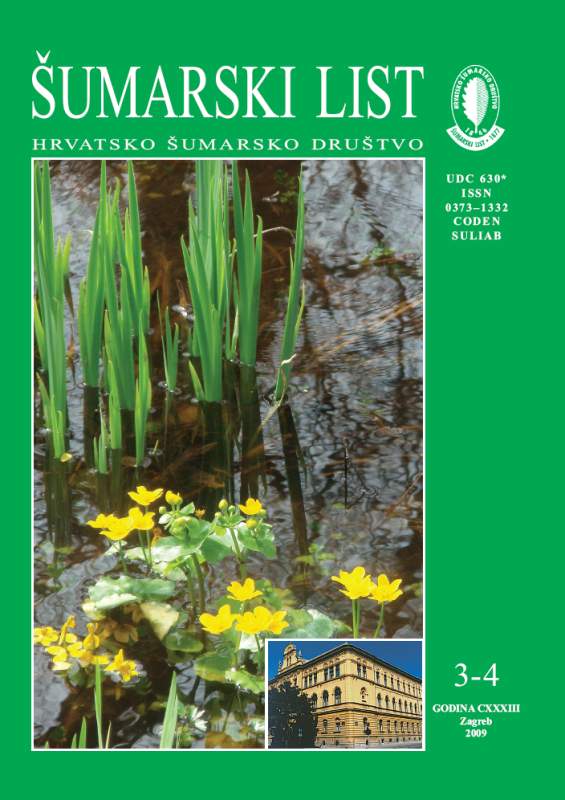
broj: 3-4/2009
pdf (5,7 MB) |
|
||||||||||||||
| RIJEČ GLAVNOGA UREDNIKA | ||
| Branimir Prpić | ||
| ON THE RELATIONSHIP BETWEEN FORESTRY AND OFFICIAL NATURE PROTECTION pdf HR EN | 120 | |
| IZVORNI ZNANSTVENI ČLANCI | ||
| Topić,V., L. Butorac, Z. Đurđević, B. Kekelić, G. Jelić | UDK 630* 232.3 (001) Cupressus sempervirens var. pyramidalis Nyman | |
| Effect of Container Type on Growth and Developtment of Seedlings of Common Cypress (Cupressus sempervirens var. pyramidalis Nyman) in Nurseriers and Forest Cultures pdf HR EN | 121 | |
| Anić,I., J. Vukelić, S. Mikac, D. Bakšić, D. Ugarković | UDK 630* 181.2 (001) Abies alba Mill. | |
| Effects of Global Climate Change on the Ecological Niche of Silver Fir(Abies albaMill.) in Croatia pdf HR EN | 135 | |
| Summary: The aim of this research is to determine the following: the fundamental ecological niche or potential distribution range of silver fir in Croatia on the basis of selected climatic factors, differences between parts of fir distribution range with reference to the selected climatic factors and changes in the ecological niche in terms of the climate change model for the period 2000 – 2100. Climatic data for the period 1950 – 2000 used in this work were taken from the Worldclime database (Hijmans et al. 2005). Eight climatic variables and relief factors were employed to construct the prognostic model, such as altitute (m), slope (°) and others. Highly correlated variables were rejected. To predict climate changes for the period 2000 – 2100, a CCM3 model (Climate Change Model) was used, which is based on double the current level of greenhouse gases (CO, CH 4, N2O, CFC-11 and CFC-12) (Govindasamy et al. 2003). All climatic data in grid form were 2entered in 30-second resolution (~ 1 km2). Data on fir occurrence in Croatia were taken from the latest research on the distribution of forest sites (Vukelić et al. 2008), ICP plots, phytocoenological relevé database of the Republic of Croatia and management plans. In each plot fir occurrence was graded with binary variables – 1 (present) and 0 (absent). Independent variables used to construct the logistic model and prediction included elevation – Elev (m), slope – Slope (°), mean annual temperature – MeanAnnT (°C), mean annual temperature range – MeanAnnTR (°C), obtained as the difference between the mean temperature of the warmest and the coldest month, then the ratio between the mean monthly temperature range and the mean annual temperature range – IsoTherm (°C), mean temperature of the driest quarter - MeanTDQ (°C), mean temperature of the coldest quarter – Mean TCM (°C), mean annual precipitation quantity – MeanAnnP (mm), mean annual precipitation in the warmest quarter – MeanPWQ (mm) and coefficient of seasonal precipitation variation – PreS (mm). The distribution range of fir was divided into three parts: DIN – the Dinaric part of fir range within the community Omphalodo-Fagetum /Tregubov 1957/ Marinček et al. 1993, ACD – the Dinaric part of acidophilic fir communities (Blechno-Abietetum Horvat /1938/ 1950) and PAN – the Pannonian part encompassing fir range within the community Festuco drymeiae-Abietetum (Vukelić et Baričević 2007). Discriminant analysis (DA) was used to analyze and visualize ecological niches within the range. The prognostic model of ecological niches for the current distribution range of fir and that for the period until 2100 with regard to climate change model was made by means of logistic regression (LOGREG), expressions: p(y)= exp(LP)/(1+exp(LP)), where LP represents linear combination of independent variables (Flantua et al. 2007). According to the research, the current range of silver fir in Croatia does not differ dramatically (p . 0.9) from the potential one. This suggests that longlasting forest management did not contribute to its reduction. However, the selected climatic factors could have a signficant effect on the occurrence of silver fir in Croatia. The prognostic model shows that in conditions of global climate changes its potential range (p = . 0.9) in Croatia could decrease by ~ 85% in the period 2000 – 2100. Key words: Abies albaMill.; climatic factors; distribution range; ecological niche; global climate changes | ||
| Klobučar,D., R. Pernar | UDK 630* 585 (001) | |
| Artificial Neural Networks in the Estimation of Stand Density from Cyclic Recordings pdf HR EN | 145 | |
| Pernek,M., D. Matošević | UDK 630* 453 (001) Obolodiplosis robiniae | |
| Black Locust Gall Midge(Obolodiplosis robiniae), New Pest on Black Locust Trees and first Record of ParasitoidPlatygaster robinaein Croatia pdf HR EN | 157 | |
| Butorac,L., V. Topić, G. Jelić | UDK 630* 116 + 434 (001) Pinus halepensis Mill. | |
| Sufrace Runoff and Soil Loss in Burnt Stands of Aleppo Pine(Pinus halepensisMill.) Growing on Colluvial Soils pdf HR EN | 165 | |
| Vuletić,D., S. Krajter, M. Mrazek,A. Ćorić | UDK 630* 652 + 289 (001) | |
| Non Wood Forest Products and Services – Are we Using them Enough? pdf HR EN | 173 | |
| Govorčin,S., T.Sinković, R. Hrčka | UDK 630* 812 + 813 (001) Fraxinus excelsior L. | |
| Some Physical and Mechanical Properties of Recent and Heat Treated Ash– Fraxinus Excelsior L. pdf HR EN | 185 | |
| ZNANSTVENI I STRUČNI SKUPOVI | ||
| Jakovac, Hranislav | ||
| Biological-Ekological and Energetic Characteristics of Indigobush (Amorpha fructicosaL.) in Croatia PDF | 202 | |


